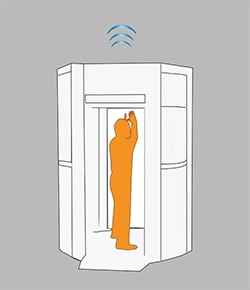Radiation from Airport Security Screening
When flying in the United States or elsewhere, we are subject to airport security screening. Airport security screening in the United States includes the use of body-scanning units that release low levels of radiation.
How am I exposed to radiation from airport security screening?

Body scanners using millimeter wave technology are being used in United States airports. Image credit: Transportation Security Administration
The Transportation Security Administration (TSA) is using body-scanning units at a number of U.S. airports. These body-scanning units traditionally use millimeter-wave technology.
Millimeter-wave technology uses non-ionizing radiation in the form of low-level radio waves to scan a person’s body. A millimeter-wave body scanner uses two antennas that rotate around a person’s body to construct a 3-D image that resembles a fuzzy photo negative. The image is sent to a remote monitor. Millimeter-wave technology does not use x-rays and does not add to a person’s ionizing radiation dose.
For more information on non-ionizing radiation, click here
You may have heard that some airports previously used “backscatter” technology, which involved x-rays. Backscatter technology is no longer being used in U.S. airport security screenings.
As mentioned above, the United States uses millimeter-wave technology in airport security scans. This form of technology uses low-energy non-ionizing radiation that releases thousands of times less energy than a cell phone.
The U.S. Food and Drug Administration (FDA) has federal authority to set standards for machines that produce radiation, including millimeter-wave security screening systems.